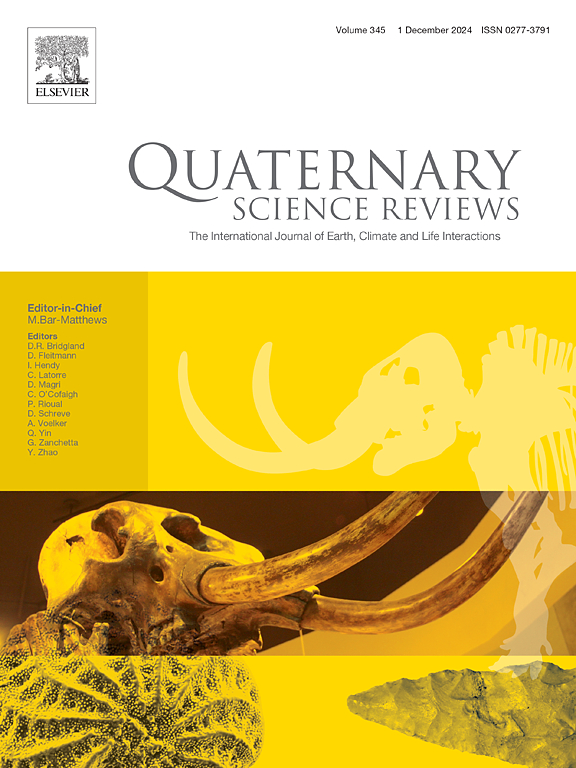青藏高原东部若尔盖盆地全新世中期以来植被变化与放牧活动
IF 3.2
1区 地球科学
Q1 GEOGRAPHY, PHYSICAL
引用次数: 0
摘要
放牧活动的大型食草动物是维持青藏高原高海拔地区人类永久定居的最重要生产要素,其种群变化是全新世以来气候变化与人类活动相互作用的产物。利用若尔盖盆地中全新世以来的花粉和真菌孢子化石记录,揭示了若尔盖盆地植被变化和放牧活动的历史及其控制因素。结果表明,若尔盖盆地植被变化和放牧活动的历史可划分为3个阶段:(ⅰ)8.5 ~ 5.8 ka期间,若尔盖盆地发育以苏科植物为主的高寒草甸,树花粉含量最高,热液条件最佳。这一阶段嗜粪真菌孢子浓度较低,可能与野生食草动物有关。(ⅱ)5.8 ~ 3.6 ka期间,以苏科植物为主的高寒草甸进一步发育,树花粉含量略有下降,气候开始向干旱转变,但总体气候仍保持温暖湿润。这一阶段粪亲真菌孢子不断出现,孢子浓度逐渐增加,表明流域有人类活动,在5.8ka左右开始有放牧活动。(ⅲ)在约3.6 ~ 0 ka期间,植被类型转变为以藜科和菊科为主的荒漠草原,0.5 ka后,高寒草甸重新发育。树木花粉含量明显下降,气候以凉爽干燥为主。以粪亲真菌孢子浓度为代表的放牧活动在约3.6 ka后开始逐渐增加。这一阶段的放牧活动与干冷气候呈负相关。干燥凉爽的气候是促进若尔盖盆地畜牧业发展的关键因素之一。研究结果进一步补充了青藏高原东部地区人类活动演变和环境背景,对了解气候变化对高原环境中人类生存策略的影响具有一定的参考意义。本文章由计算机程序翻译,如有差异,请以英文原文为准。
Vegetation change and grazing activities since the middle Holocene in the Zoige Basin, eastern Tibetan Plateau, China
Large herbivores of grazing activities are the most important production factor to maintain the permanent settlement of human beings in the high-altitude area of the Tibetan Plateau, China, and their population changes are the products of the interaction between climate change and human activities since the Holocene. Using pollen and fungal spore fossil records from a profile since mid-Holocene in the Zoige Basin, the history and controlling factors of vegetation change and grazing activities were revealed. The results showed that the history of vegetation change and grazing activities in the Zoige Basin could be divided into three stages: (ⅰ) During the period of 8.5–5.8 ka, alpine meadow dominated by Cyperaceae developed in the Zoige Basin with the highest tree pollen content and the best hydrothermal conditions. The low concentration of coprophilous fungal spore at this stage was probably related to wild herbivores. (ⅱ) During the period of 5.8–3.6 ka, the alpine meadow dominated by Cyperaceae developed further, the tree pollen content decreased slightly, and the climate began to change to drought, but the overall climate was still warm and humid. At this stage, coprophilous fungal spores occurred continuously and their concentration gradually increased, suggesting that there were human activities in the basin and grazing activities began at about 5.8ka. (ⅲ) During about 3.6–0 ka, the vegetation type changed to the desert steppe dominated by Chenopodiaceae and Asteraceae, and after 0.5 ka, the alpine meadow redeveloped. The pollen content of trees decreased significantly, and the climate was mainly cool and dry. Grazing activities, as represented by the concentration of coprophilous fungi spores, began to increase gradually after about 3.6 ka. There was a reverse correlation between grazing activities and the dry and cool climate in this stage. The dry and cool climate was one of the key factors to promote the development of grazing in the Zoige Basin. The research results further complement the evolution of human activities and environmental background in the eastern Tibetan Plateau, and have certain reference significance for understanding the impact of climate change on human survival strategies in the plateau environment.
求助全文
通过发布文献求助,成功后即可免费获取论文全文。
去求助
来源期刊

Quaternary Science Reviews
地学-地球科学综合
CiteScore
7.50
自引率
15.00%
发文量
388
审稿时长
3 months
期刊介绍:
Quaternary Science Reviews caters for all aspects of Quaternary science, and includes, for example, geology, geomorphology, geography, archaeology, soil science, palaeobotany, palaeontology, palaeoclimatology and the full range of applicable dating methods. The dividing line between what constitutes the review paper and one which contains new original data is not easy to establish, so QSR also publishes papers with new data especially if these perform a review function. All the Quaternary sciences are changing rapidly and subject to re-evaluation as the pace of discovery quickens; thus the diverse but comprehensive role of Quaternary Science Reviews keeps readers abreast of the wider issues relating to new developments in the field.
 求助内容:
求助内容: 应助结果提醒方式:
应助结果提醒方式:


